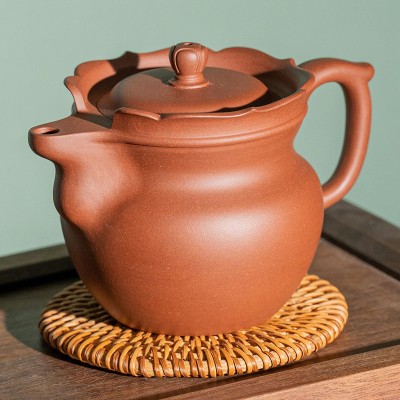







This is a type of teapot shape that was created during the Yuan Dynasty. It's called "SengMao" because the shape of the spout resembles a monk's hat. The shape of the teapot has a raised lip, a low front and high back, a duck-bill shaped spout, and the lid rests inside the lip. It has a narrow neck, a bulging belly, a circular foot, and a curved handle, and is characterized by a strong ethnic minority style.. Initially, it was used exclusively for Buddhist monks to drink tea, but over time it gradually became a classic shape of the square zisha teapot.
 Delivery
Delivery
Free shipping within 1 to 3 days. ETA:5-7 days
 Returns
Returns
Within 28 days after delivery date.
 Security
Security
SSL | GDRP used to ensure information security.
Guarantee safe & secure checkout
Data sheet
This is a type of teapot shape that was created during the Yuan Dynasty. It's called "SengMao" because the shape of the spout resembles a monk's hat. The shape of the teapot has a raised lip, a low front and high back, a duck-bill shaped spout, and the lid rests inside the lip. It has a narrow neck, a bulging belly, a circular foot, and a curved handle, and is characterized by a strong ethnic minority style.. Initially, it was used exclusively for Buddhist monks to drink tea, but over time it gradually became a classic shape of the square zisha teapot.
This is a type of teapot shape that was created during the Yuan Dynasty. It's called "SengMao" because the shape of the spout resembles a monk's hat. The shape of the teapot has a raised lip, a low front and high back, a duck-bill shaped spout, and the lid rests inside the lip. It has a narrow neck, a bulging belly, a circular foot, and a curved handle, and is characterized by a strong ethnic minority style.. Initially, it was used exclusively for Buddhist monks to drink tea, but over time it gradually became a classic shape of the square zisha teapot.
"Shipiao" Yixing teapot- this zisha teapot is a traditional Chinese tea set characterized by its gourd-like or calabash-like shape, with a small top and large bottom, a sturdy and short spout, and a pyramid-shaped body that exudes elegance. Made from high-quality purple clay material, this teapot is known for its hardness and durability, as well as its stable and easy-to-use design. The short and powerful straight spout ensures a smooth and steady flow of water, while the pyramid-shaped body adds a touch of sophistication to any tea ceremony.
The "Banyue" Yixing teapot has always held a special place for its simplicity, elegance, and gracefulness. The "Banyue" Yixing teapot is harmonious, spacious, and concise, with a balance between outward expression and inward restraint. It is like a beautiful piece of writing that becomes more intoxicating with each read. The teapot creates a sense of longing for reunion, as expressed in the Chinese saying, "the bright moon sends thoughts a thousand miles, while the half moon intensifies them even more." The teapot not only speaks of longing but also expresses the traditional Chinese cultural yearning for "full moon, full people." Therefore, the "Banyue" Yixing teapot is a true embodiment of Chinese culture.
"Shipiao" Yixing teapot- this zisha teapot is a traditional Chinese tea set characterized by its gourd-like or calabash-like shape, with a small top and large bottom, a sturdy and short spout, and a pyramid-shaped body that exudes elegance. Made from high-quality purple clay material, this teapot is known for its hardness and durability, as well as its stable and easy-to-use design. The short and powerful straight spout ensures a smooth and steady flow of water, while the pyramid-shaped body adds a touch of sophistication to any tea ceremony.
A flattened persimmon-shaped teapot is called a "Short Pan," a slightly taller and flattened spherical-shaped teapot is called a "Medium Pan," and a teapot with a taller and pear-shaped body is called a "Tall Pan." When their daughters got married, they would give a Pan teapot as part of their dowry, hoping that their daughters would be able to live a prosperous life like "Pan Shicheng" who the inventor of the "pan" teapot. teapots that are passed down as part of the dowry are not necessarily used for brewing tea, but can also be placed on dressing tables to hold hair oil. After the female owner passes away, they are often used as burial objects to show gratitude to her family for raising her.
The "Longdan" Yixing teapot, also known as the Dragon Ball Teapot, has an oval shape with a flat bottom and a smaller top, resembling an egg. It is crafted using traditional handmade techniques, with intricate carvings and fine texture that result in a deep and rich color. This teapot has excellent heat preservation and enhances the aftertaste of tea, making it suitable for brewing various types of tea. It is both elegant and practical, making it a highly sought-after Zisha teapot.
The apple-shaped Yixing teapot is another unique example of zisha teapot. As the name suggests, it is designed to resemble an apple.
The Xishi yixing teapot is the quintessential model and the most popular style of Yixing clay teapot. It boasts a round and plump body, a cut lid, a short spout, and an inverted handle. The pot's body resembles the full breast of a young woman, while the knob on the lid is shaped like a nipple. The bottom of the pot curves inward naturally, and the handle is fashioned like an upside-down ear, reminiscent of the hairstyle of ancient Chinese women. When pouring tea, the handle resembles the slender waist of a beautiful woman. The Xishi teapot is renowned for its unique ability to brew tea, allowing the tea leaves to fully expand and release a more intense aroma and flavor.
"Shipiao" Yixing teapot- this zisha teapot is a traditional Chinese tea set characterized by its gourd-like or calabash-like shape, with a small top and large bottom, a sturdy and short spout, and a pyramid-shaped body that exudes elegance. Made from high-quality purple clay material, this teapot is known for its hardness and durability, as well as its stable and easy-to-use design. The short and powerful straight spout ensures a smooth and steady flow of water, while the pyramid-shaped body adds a touch of sophistication to any tea ceremony.
The Xishi yixing teapot is the quintessential model and the most popular style of Yixing clay teapot. It boasts a round and plump body, a cut lid, a short spout, and an inverted handle. The pot's body resembles the full breast of a young woman, while the knob on the lid is shaped like a nipple. The bottom of the pot curves inward naturally, and the handle is fashioned like an upside-down ear, reminiscent of the hairstyle of ancient Chinese women. When pouring tea, the handle resembles the slender waist of a beautiful woman. The Xishi teapot is renowned for its unique ability to brew tea, allowing the tea leaves to fully expand and release a more intense aroma and flavor.
"Shipiao" Yixing teapot- this zisha teapot is a traditional Chinese tea set characterized by its gourd-like or calabash-like shape, with a small top and large bottom, a sturdy and short spout, and a pyramid-shaped body that exudes elegance. Made from high-quality purple clay material, this teapot is known for its hardness and durability, as well as its stable and easy-to-use design. The short and powerful straight spout ensures a smooth and steady flow of water, while the pyramid-shaped body adds a touch of sophistication to any tea ceremony.
"Xubian" yixing teapot is considered one of the most challenging shapes to create in traditional handmade purple clay pottery. In fact, it's said in the industry that "one point of shaping equals one point of difficulty in forming." To create this teapot, the potter must start with a cylindrical shape and then use a "clay pat" to gently tap and flatten the clay without causing it to collapse. This requires a great deal of skill and precision in manual operation, making it a difficult and time-consuming process. Despite the challenges, the Xubian teapot is highly valued by collectors and tea enthusiasts for its unique and elegant shape, as well as its ability to brew tea with a rich and full flavor.
"Hanwa" Yixing teapot is shaped like a cylindrical jar, which appears straight up and down, but has an arched middle that gives it a strong tension. The lid is a large, slightly bulging and curved circle, with a bridge-shaped knob on top that slopes gently. The straight spout is of moderate length, while the ear-shaped handle is slightly flattened in the middle. Both the spout and handle are polygonal, providing visual changes and a classic combination of square and round in art.
The design of the "Xubian" zisha teapot is a combination of the elements of the "Xubian" and the "Gongdeng". "Xubian" refers to the flat shape of the body of the pot, while "Gongdeng" refers to the shape of the lid of the pot, which is like a palace lamp. This design not only retains the characteristics of traditional purple clay pots, but also adds some new elements, making the "Biandeng" more ornamental and collectible.
The Xishi yixing teapot is the quintessential model and the most popular style of Yixing clay teapot. It boasts a round and plump body, a cut lid, a short spout, and an inverted handle. The pot's body resembles the full breast of a young woman, while the knob on the lid is shaped like a nipple. The bottom of the pot curves inward naturally, and the handle is fashioned like an upside-down ear, reminiscent of the hairstyle of ancient Chinese women. When pouring tea, the handle resembles the slender waist of a beautiful woman. The Xishi teapot is renowned for its unique ability to brew tea, allowing the tea leaves to fully expand and release a more intense aroma and flavor.
"Julun" yixing teapot- this "Julun" zisha teapot is designed for practicality, with a spout that ensures smooth water flow and a handle that is easy to grip. The lid is also uniquely designed for easy removal. Despite its distinctive and eye-catching appearance, the "Julun" teapot is a functional and practical utensil that is highly valued by tea enthusiasts for its ability to brew tea effectively and efficiently. Its unique shape allows tea leaves to fully expand, releasing more aroma and flavor. The name "JuLun" comes from its shape, which resembles an upside-down cartwheel. This teapot is not only aesthetically pleasing but also highly functional, making it a popular choice among tea lovers and collectors.
"Shuiping“ zisha teapot-Chinese Kung Fu tea is a traditional brewing method that involves putting a large amount of tea leaves in a teapot and only brewing with boiling water, allowing the tea juice to slowly seep out. To achieve this, the teapot must be placed in a tea bowl or tea sea, with hot water poured around the outside of the teapot, causing it to float in the hot water and allowing the tea juice to be brewed. This requires an exquisite production process, with the clay used for the spout and handle of the teapot being of equal quality. When the teapot floats on the surface of the water, it must maintain a horizontal position without tilting, hence the name "shuiping" teapot.
NOTICE : Cookies ensure the smooth running of our services and improve user experience,Using these, you accept the use of cookies. Learn More.